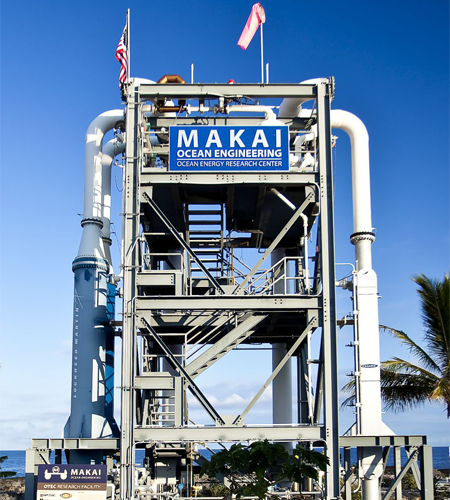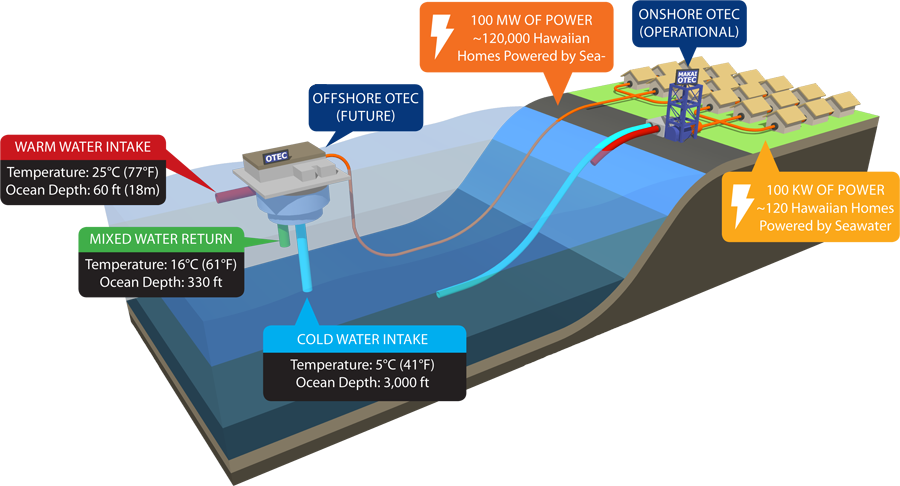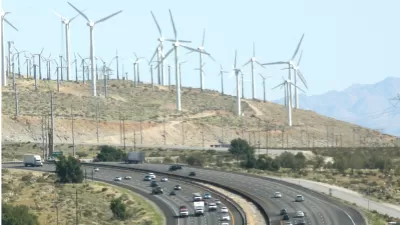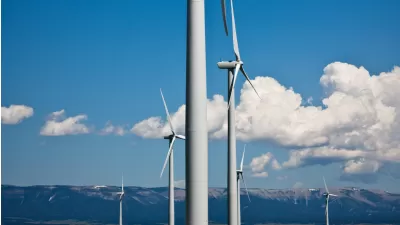It's called Ocean Thermal Energy Conversion, or OTEC, and the world's largest plant was dedicated in Hawaii on August 21. It produces renewable energy by using the temperature difference between the ocean's deep cold water and warm surface water.
Emission-free energy is now being produced in Hawaii by Makai Ocean Engineering, thanks to funding by the Office of Naval Research through the Hawaii Natural Energy Institute," states Makai's news release. The $5 million, 105-kilowatt demonstration plant on the Big Island "only generates enough electricity to power 120 homes," writes Cole Mellino for EcoWatch. "But to date, it’s the largest such plant in the world."

Credit: Makei Ocean Engineering
The company estimates that all of Hawaii’s electricity needs could be met by about 12 commercial-scale OTEC plants. They already have plans to construct a 1-megawatt facility in Japan.
“Anywhere tropical with deep water is ideal, especially if they import their fuel,” says Duke Hartman, vice president of business development at Makai.
While technically classified as a type "marine renewable energy," it's actually a form of solar energy, captured by the ocean and converted to electricity. "That’s beautiful because we can extract that energy 24/7 and use that power any time we want it, totally eliminating the need for an energy storage system,” states Hartman.
"Heat exchangers are really the key component to OTEC," states Hartman in this five-minute YouTube video as he point to the three pipes, standing on top of the plant.

Credit: Makei Ocean Engineering
"OTEC is a technology that the Navy has a significant interest for generating power at Naval bases around the world," states the naval research paper, "Understanding Predictability of the Ocean" [PDF]. "By using an [sic] Rankine engine cycle with fluorine gas cooled by deep ocean water and warmed by surface waters, turbines are used to generate electrical power that is sent back to shore." [The video explains it in more detail.].
"The breakthrough marks the first true closed-cycle OTEC plant to be connected to a U.S. electrical grid, and represents a major achievement for Hawaii, the United States, and marine renewable energy," according to the news release.
The biggest challenge remains will be funding. "We need a visionary investor to get us past the expensive pilot project into the large-scale commercial projects," states Hartman.
FULL STORY: Hawaii Flips Switch on World’s Largest Ocean Harvesting Clean Energy Plant

Alabama: Trump Terminates Settlements for Black Communities Harmed By Raw Sewage
Trump deemed the landmark civil rights agreement “illegal DEI and environmental justice policy.”

Planetizen Federal Action Tracker
A weekly monitor of how Trump’s orders and actions are impacting planners and planning in America.

The 120 Year Old Tiny Home Villages That Sheltered San Francisco’s Earthquake Refugees
More than a century ago, San Francisco mobilized to house thousands of residents displaced by the 1906 earthquake. Could their strategy offer a model for the present?

Indy Neighborhood Group Builds Temporary Multi-Use Path
Community members, aided in part by funding from the city, repurposed a vehicle lane to create a protected bike and pedestrian path for the summer season.

Congestion Pricing Drops Holland Tunnel Delays by 65 Percent
New York City’s contentious tolling program has yielded improved traffic and roughly $100 million in revenue for the MTA.

In Both Crashes and Crime, Public Transportation is Far Safer than Driving
Contrary to popular assumptions, public transportation has far lower crash and crime rates than automobile travel. For safer communities, improve and encourage transit travel.
Urban Design for Planners 1: Software Tools
This six-course series explores essential urban design concepts using open source software and equips planners with the tools they need to participate fully in the urban design process.
Planning for Universal Design
Learn the tools for implementing Universal Design in planning regulations.
Clanton & Associates, Inc.
Jessamine County Fiscal Court
Institute for Housing and Urban Development Studies (IHS)
City of Grandview
Harvard GSD Executive Education
Toledo-Lucas County Plan Commissions
Salt Lake City
NYU Wagner Graduate School of Public Service




























